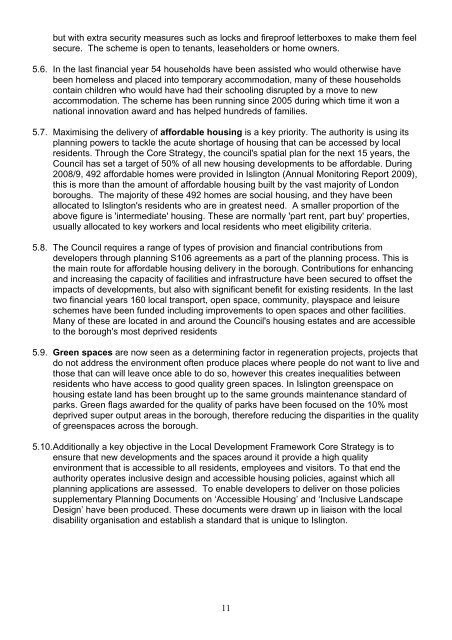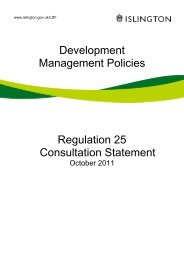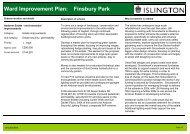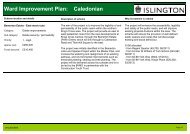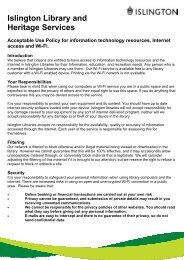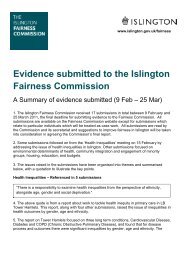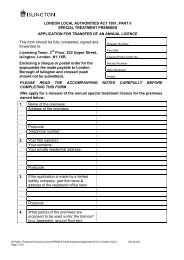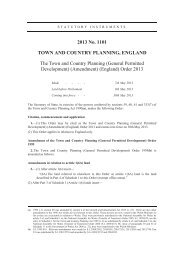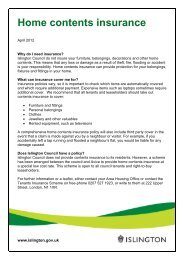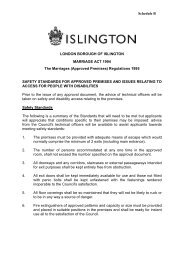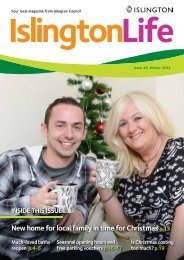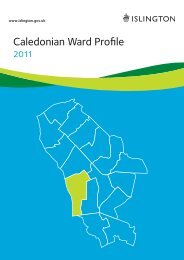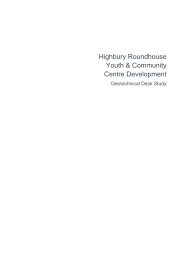Two Islingtons: Understanding the Problem - Islington Council
Two Islingtons: Understanding the Problem - Islington Council
Two Islingtons: Understanding the Problem - Islington Council
You also want an ePaper? Increase the reach of your titles
YUMPU automatically turns print PDFs into web optimized ePapers that Google loves.
ut with extra security measures such as locks and fireproof letterboxes to make <strong>the</strong>m feel<br />
secure. The scheme is open to tenants, leaseholders or home owners.<br />
5.6. In <strong>the</strong> last financial year 54 households have been assisted who would o<strong>the</strong>rwise have<br />
been homeless and placed into temporary accommodation, many of <strong>the</strong>se households<br />
contain children who would have had <strong>the</strong>ir schooling disrupted by a move to new<br />
accommodation. The scheme has been running since 2005 during which time it won a<br />
national innovation award and has helped hundreds of families.<br />
5.7. Maximising <strong>the</strong> delivery of affordable housing is a key priority. The authority is using its<br />
planning powers to tackle <strong>the</strong> acute shortage of housing that can be accessed by local<br />
residents. Through <strong>the</strong> Core Strategy, <strong>the</strong> council's spatial plan for <strong>the</strong> next 15 years, <strong>the</strong><br />
<strong>Council</strong> has set a target of 50% of all new housing developments to be affordable. During<br />
2008/9, 492 affordable homes were provided in <strong>Islington</strong> (Annual Monitoring Report 2009),<br />
this is more than <strong>the</strong> amount of affordable housing built by <strong>the</strong> vast majority of London<br />
boroughs. The majority of <strong>the</strong>se 492 homes are social housing, and <strong>the</strong>y have been<br />
allocated to <strong>Islington</strong>'s residents who are in greatest need. A smaller proportion of <strong>the</strong><br />
above figure is 'intermediate' housing. These are normally 'part rent, part buy' properties,<br />
usually allocated to key workers and local residents who meet eligibility criteria.<br />
5.8. The <strong>Council</strong> requires a range of types of provision and financial contributions from<br />
developers through planning S106 agreements as a part of <strong>the</strong> planning process. This is<br />
<strong>the</strong> main route for affordable housing delivery in <strong>the</strong> borough. Contributions for enhancing<br />
and increasing <strong>the</strong> capacity of facilities and infrastructure have been secured to offset <strong>the</strong><br />
impacts of developments, but also with significant benefit for existing residents. In <strong>the</strong> last<br />
two financial years 160 local transport, open space, community, playspace and leisure<br />
schemes have been funded including improvements to open spaces and o<strong>the</strong>r facilities.<br />
Many of <strong>the</strong>se are located in and around <strong>the</strong> <strong>Council</strong>'s housing estates and are accessible<br />
to <strong>the</strong> borough's most deprived residents<br />
5.9. Green spaces are now seen as a determining factor in regeneration projects, projects that<br />
do not address <strong>the</strong> environment often produce places where people do not want to live and<br />
those that can will leave once able to do so, however this creates inequalities between<br />
residents who have access to good quality green spaces. In <strong>Islington</strong> greenspace on<br />
housing estate land has been brought up to <strong>the</strong> same grounds maintenance standard of<br />
parks. Green flags awarded for <strong>the</strong> quality of parks have been focused on <strong>the</strong> 10% most<br />
deprived super output areas in <strong>the</strong> borough, <strong>the</strong>refore reducing <strong>the</strong> disparities in <strong>the</strong> quality<br />
of greenspaces across <strong>the</strong> borough.<br />
5.10. Additionally a key objective in <strong>the</strong> Local Development Framework Core Strategy is to<br />
ensure that new developments and <strong>the</strong> spaces around it provide a high quality<br />
environment that is accessible to all residents, employees and visitors. To that end <strong>the</strong><br />
authority operates inclusive design and accessible housing policies, against which all<br />
planning applications are assessed. To enable developers to deliver on those policies<br />
supplementary Planning Documents on ‘Accessible Housing’ and ‘Inclusive Landscape<br />
Design’ have been produced. These documents were drawn up in liaison with <strong>the</strong> local<br />
disability organisation and establish a standard that is unique to <strong>Islington</strong>.<br />
11


